Buy HD e-Books & Text —— www.ccelian.com
the Art of Nao
Scrolls: 1 . 2a . 2b . 3 . 4 . 5 . 6 . 7 . 8 . 9 . 10 . 11 . 12 . 13 . 14 . 15 . 16 . 17 .
18 . 19 . 20 . 21 . 22 . 23 . 24 . 25 . 26 . 27 . 28 . 29 . 30 . 31 . 32 . 33 . 34 .
< Scroll 30 ____________________________________________________ Scroll 32 >

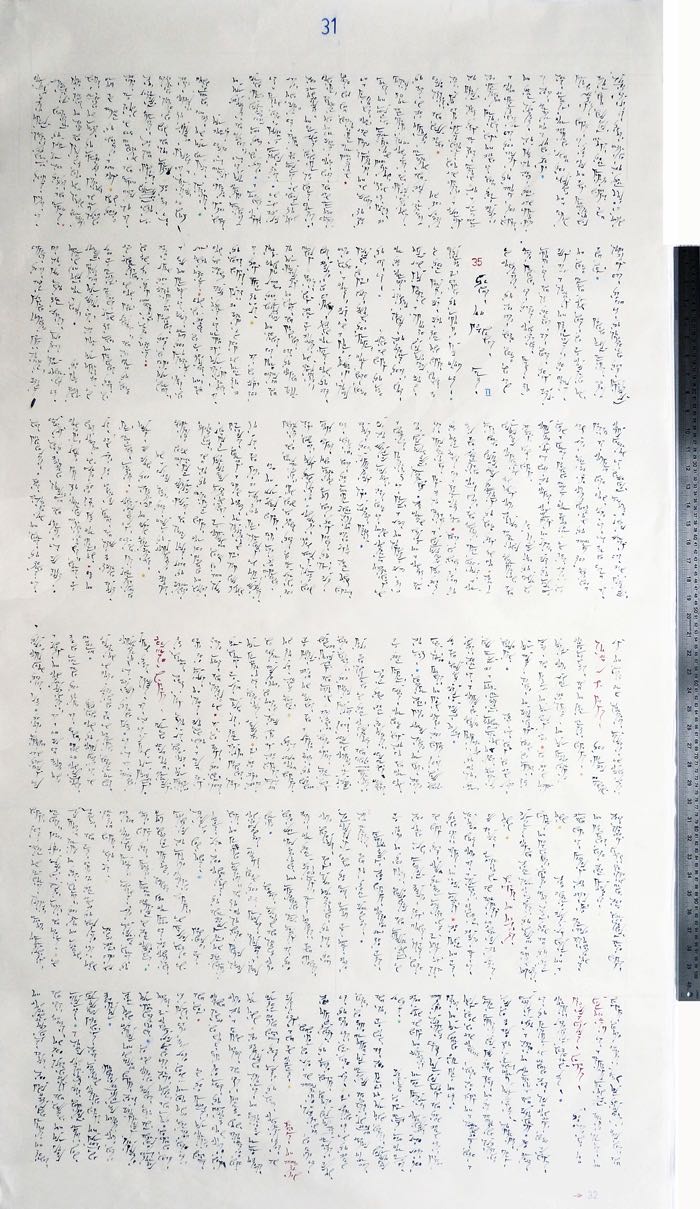
Scroll 31 . 93 x 169 cm ~36 x ~ 66.5 inches
_____________________
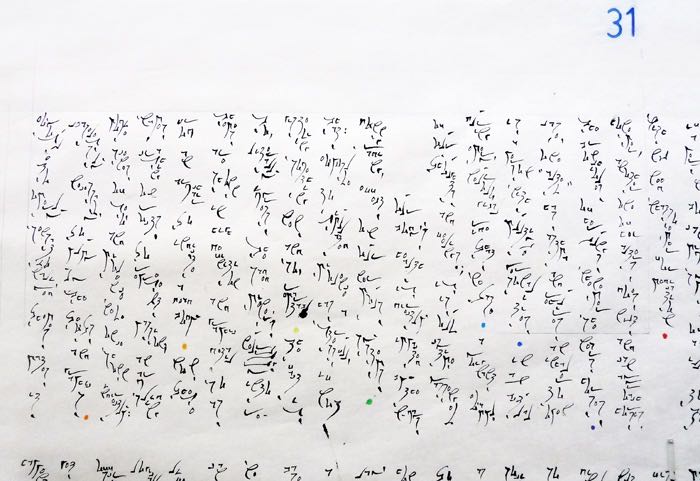
Scroll 31-section 1.1
> exposure to overly-sensationalized themes makes it ceaselessly necessary to pump up the texts and graphics. Movie scenes of violence and sex were once shown indirectly: waves crashing on rocks to represent physical passion; an arm sliding from an armchair to indicate a dead body.) Now, these themes are shown in high definition and graphic detail so as to, literally, impress the jaded viewer’s neurology into registering something new and so, remarkable. The fact is that: exposure to simulated violence has a stressful, if not downgrading, effect on our nervous systems.
Our body’s health is directly impacted by the N-maps of our thoughts and feelings; it is our captive passenger during every neurological ride that we take. A poignant example is a person with multiple personalities. In an actual case, one "alter" has asthma and requires an inhaler to open the bronchioles of her lungs whenever she nears horses. However, another one of her alters does not, and can approach horses with no need whatsoever for medication.
___________________
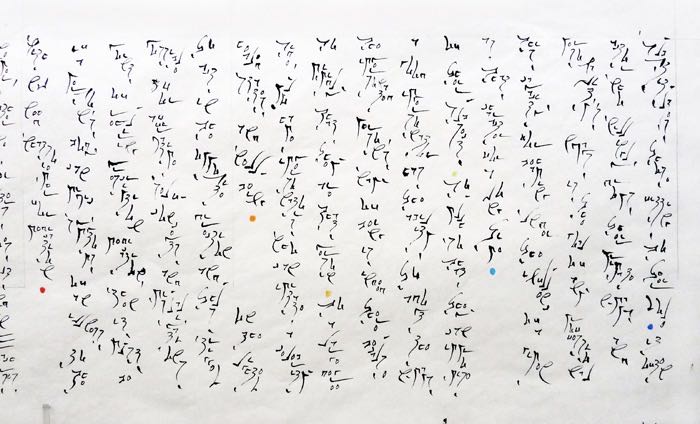
Scroll 31-section 1.2
If a person’s body can mimic symptoms of an illness to the point of requiring prescription medication, then it must be possible for affirmative self-concepts and visualizations to act in the opposite direction and thus, trigger healed states and well-being.
On the lighter side, you have impersonators who can imitate a celebrity so vividly that they are that person. To a large degree, the impersonated person’s way of being is indeed there because, a good impersonator has the ability to adopt the N-maps of their subject. So much so that they can improvise as that character for a long time.
This capacity for behaving under the influence of a given personality’s N-maps is the goal of any professional actor who willingly drops their private N-maps and substitutes those fitting to their role. It often >
_______________
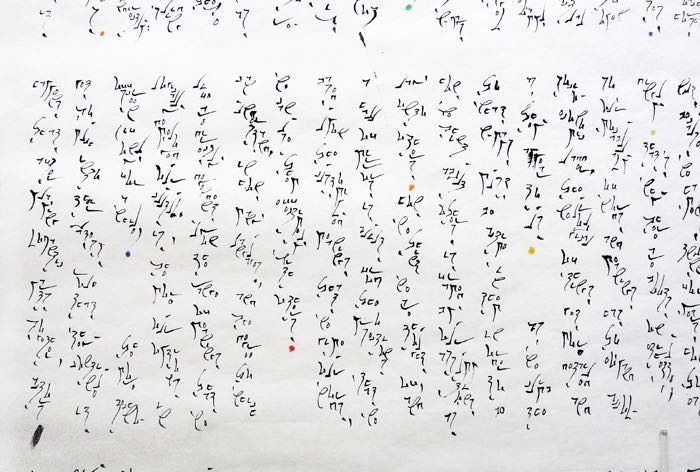
Scroll 31-section 2.1
> happens that after playing romantic parts together, actors get so much into their latest role that they continue it offscreen (if only for a while).
The more technologically developed our culture is, the more our options in life are directly dependent on the range of meanings that we can understand, in how many languages, and the degree to which we can use them effectively with others.
Based upon the customized meanings we give our words, a hall of mirrors is built from the projections that we lay onto others. How we think we are thought of, and how we think about others is framed by our assumptions of what N-maps must be active in them in order to be as they appear to us.
As we climb the socio-economic ladder, the neurological locations of things get more detailed and our vocabulary of words and meanings has to expand accordingly. That’s why there are books on etiquette; >
_________________
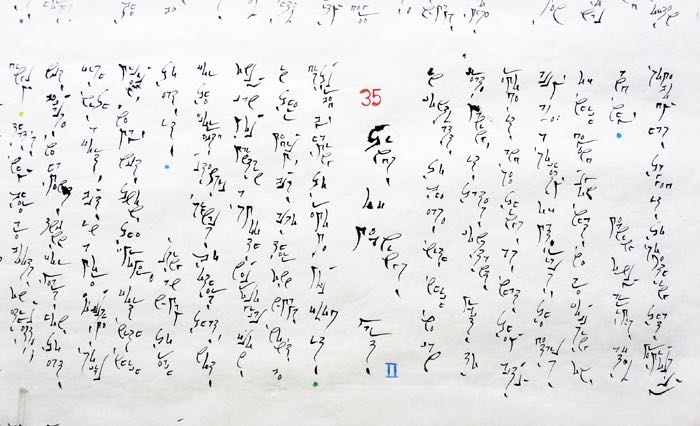
Scroll 31-section 2.2
> not because we haven’t known for years how to eat fish with a fork, but, in a more exclusive social milieu, we may not know the “proper” fork with which to eat it.
Using an N-map to reach for the “correct” utensil signals to others that, not only can you maintain a smooth neurological flow in their medium, but also their own N-maps won’t be disturbed by having to remove you from it.
35 Kinds of Meanings Part II
In contrast to the ease with which we can create meaning, it takes constant practice to remove it in order to see things as what they actually are: a society of materials, the details of which depend upon what we are focusing upon and why.
Meaning only arrives after somebody has tagged it to something that previously >
_______________

Scroll 31-section 3.1
> was meaningless. This association of words to things is exactly what becoming socialized and literate is all about. However, unlike maps to external destinations, words are not located in quite the same place for everyone. Each of us can use the identical words and still be talking about very different realities. Consequently, hit-and-miss understanding occurs all along the spectrum of human interactions.
On a global scale, this failure to communicate becomes inevitable when dissimilar cultural values and social roles lead to alternate experiences, and so to dissimilar N-maps for the meanings of words. Unfamiliar neurological relationships are compounded when we add such variables whereby a given object or situation might seem well known to us and yet, be related to strangely in other cultures.
Each of our unique N-maps give rise to divergent mentalities and worldviews even when we think that we are using the same words, only translated.
________________
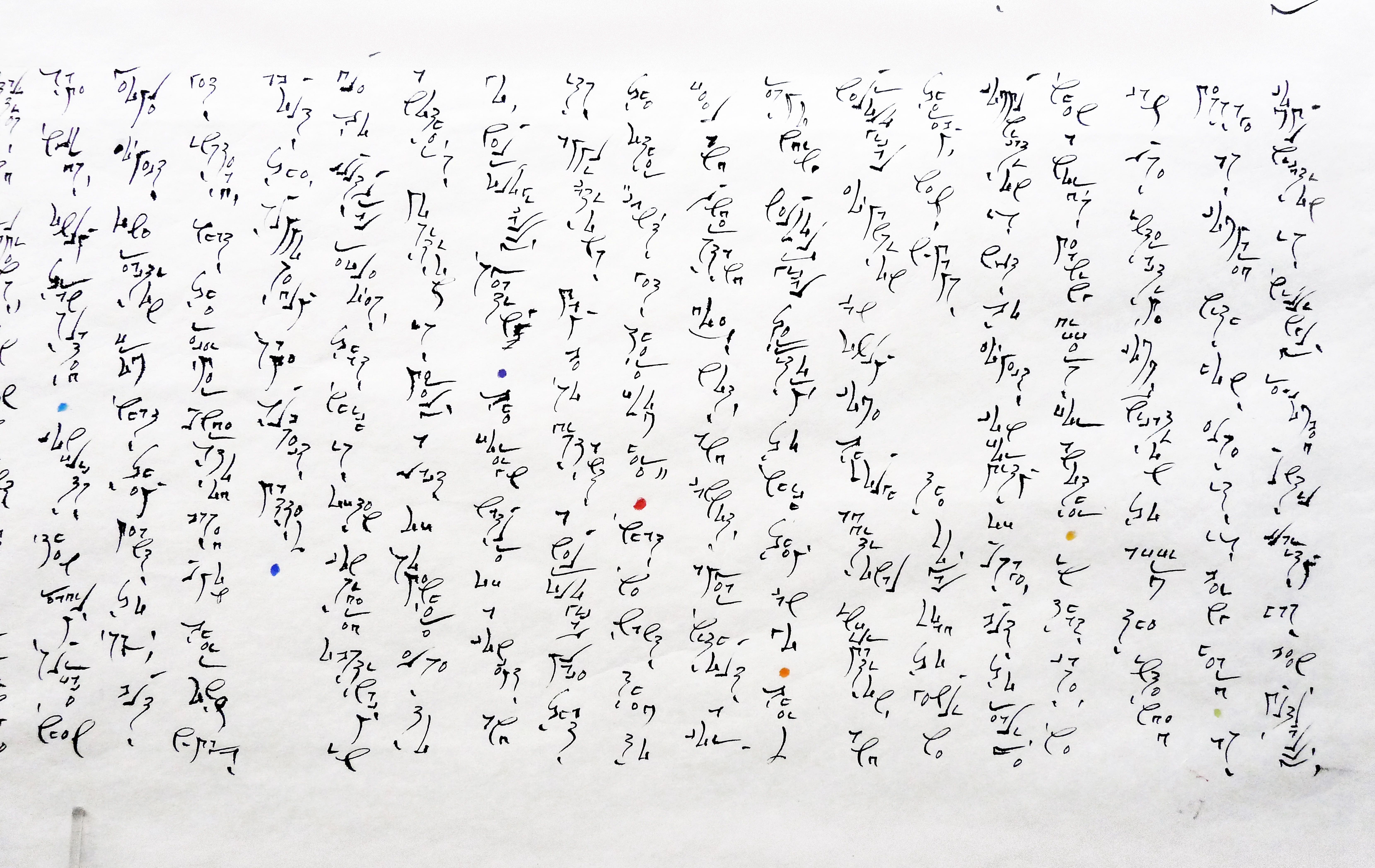
Scroll 31-section 3.2
Conflicts then readily surface when people expect one reaction from what they meant to say but get, instead, what the listener understood based upon their own N-maps about the, supposedly, same subject matter.
Due to cultural reflexes, that which is often considered obstinacy in another's position is merely the lack of somewhere else to go, neurologically speaking. The foreign nature of a concept and its applications may be so distant a neurological place that the other ”can’t get there from here”. What we want them to feel and understand does not, and cannot, appear without a corresponding neurological territory to which they can go. Their neurological expansion can only come through additional information and thereby, new N-maps.
The royal road to genuine communication is not to expect conformity of usage, but to realize when a word’s meaning differs for another. In that case, we can use interactive communication to affirm the intended message as compared with how else it is being heard. As communication is willingly re-combed until clarity has been mutually >
______________
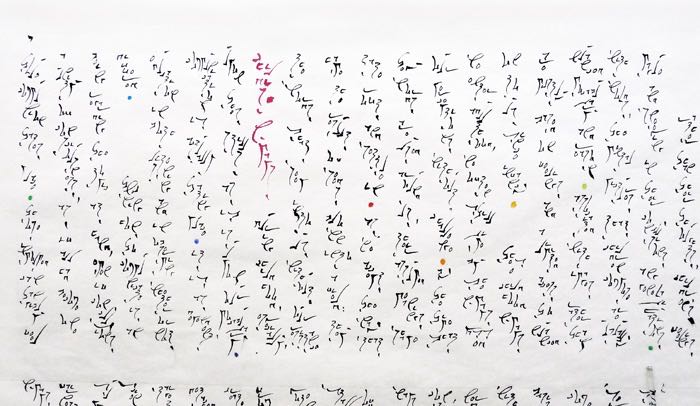
Scroll 31-section 4.1
> (omitted: achieved,) a true communion takes place. Those involved can tangibly feel a unity of consciousness, as if all had become one being regarding the topic at hand, even if conclusions differed.
Knowing how to communicate is an education in both listening and in observing whether or not communication is actually taking place. It is as dependent upon these skills as it is upon our vocabulary.
Childish N-Maps
During childhood, especially, the words that seep into us without our resistance have the result of seeds blown into a field: they take root and settle in. As we accept the way key words are used around us, their assumed meanings shape our perceptions without challenge. By the time we enter adulthood we often still live by the N-maps passed on to us since infancy.
These childhood N-maps are mostly based on feelings and a limited access to nuanced vocabulary and reason. Associated with images rather than with words, the mental pictures that children compose are usually vague and sweeping in their conclusions and generalizations.
_______________

Scroll 31-section 4.2
Rather than their thoughts, children’s feelings are their primary guides for which way to go and for how to react. Whether they make logical sense or not, these pint-size points of view create the N-maps that will underlie and support future adult ones.
Unless there is a compelling enough motivation to do so, there will rarely be root a directory reconfiguration of this infantile worldview. This is why we can lose our adult sense of autonomy when we revisit the places and people of our early life. We then obviously come under the spells of our precognitive experiences and of their first N-maps.
Social N-maps
The verbal dependency of Western societies results in countless >
_____________

Scroll 31-section 5.1
>N-maps that center on keywords: justice, freedom, opportunity, fairness, peace, love, equality, truth, rights, and others. In supposed service of these words, the triad of Religion, Science, and Art each have their chance to infiltrate its own targeted N-maps into us.
Since they have no detached external product, religions use ritualized words to create N-maps that promote preferred behaviour in their followers. From another approach, science’s need for proof has the constant potential to remove existing N-maps, in parallel with installing new ones.
Meanwhile, Art offers us the conditions to anarchically try on alternative ways of perceiving realities, and to do so with minimal social consequences—except when the art product touches a social nerve.
Whereas, religion and science come with clear implications of representing “real” reality as the basis for their authority, art objects and events come without any such obligation to take them seriously—hence the great freedom art offers both to artists and to their audiences.
_____________
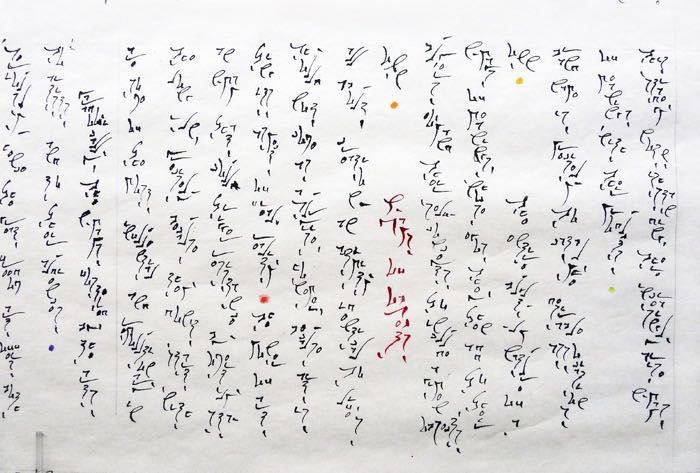
Scroll 31-section 5.2
Paradoxically, the N-maps fostered by the arts are some of the most influential and revolutionary in the long run, precisely because they don't start with an N-map that could trigger resistance by overtly stating its aspect of “real” reality. The power of Art should not come as a surprise, however, because it is all about creation—an activity identical to life’s own.
N-maps of Objects
Buyers expand their self-concepts to include a given object’s N-maps of meanings, whose egos they then add to their own. The entire built-up nature of a brand name is precisely to catalyze desirable associations of meanings with their products.
This strategy notwithstanding, there increasingly arise N-maps >
_____________

Scroll 31-section 6.1
> of conscientiousness about the manufacturing process of things and its effects on the sustainability and wellbeing of our global resources. A social consciousness inevitably creates new neurological pathways that refashion existing N-maps of purchasing behaviour.
Vintage/historical objects come with their own flavour of enfolded N-maps that automatically stimulate our imaginations. We can extend feelings into any antique/historical object by conceptualizing its time, owner, and role. We imagine what it must have been like when… or who once encountered it and, why.
In the process, our existing N-maps expand since we now have the right to describe how close we’ve come to a given object and its pedigree, now associated with our own. The background stories of historical or rare objects further demand N-maps that relate to what constitutes an authority and an expert.
N-maps of Addiction
Whenever we use an addictive substance, we give it the opportunity to create N-maps whose neurological circuits allow it to have its way with us.
___________________

Scroll 31-section 6.2 — End of Scroll 31
By letting it in to begin with, we have dropped our firewall against unchecked chemical forces and so, are now at the mercy of our own weakest neurological links.
Although we may first reach for drugs based upon an N-map of curiosity or peer pressure, continuous use lets the addictive substance hijack our neurology and begin its mathematics of our needing ever more of it.
Only when we can connect with the N-map of a self-concept with greater gravitational pull than that of the addicting substance will we be able to transform ourselves—sometimes very quickly—into a state of of liberation and autonomy. The twist is to persevere in finding that self-concept, which always exists latent within us.
Miscellaneous N-maps
The essence of neuroticism is a disproportionately active series of N-maps whose effects on our thoughts, feelings, and >
< Scroll 30 ____________________________________________________ Scroll 32 >
Scrolls: 1 . 2a . 2b . 3 . 4 . 5 . 6 . 7 . 8 . 9 . 10 . 11 . 12 . 13 . 14 . 15 . 16 . 17 .
18 . 19 . 20 . 21 . 22 . 23 . 24 . 25 . 26 . 27 . 28 . 29 . 30 . 31 . 32 . 33 . 34 .
Buy HD e-Books & Text —— www.ccelian.com
© C.C. Elian 2010 - 2016